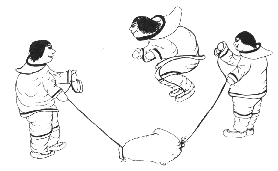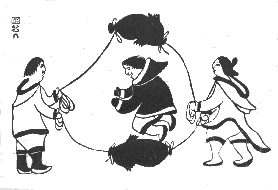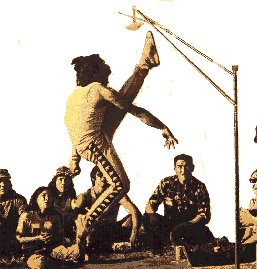
The drawing at the right is of an Inuit jumping game. It is a sketch by Sorosilutoo and is titled Kilaujatut. This Inuit artist is from Cape Dorset on Baffin Island (Government of Canada: Ministry of Indian & Northern Affairs, 1975, #QS-8050-000-BB-A1).
Pitseolak who is a noted Inuit artist from the Cape Dorset cooperative, had this to say about the illustrated jumping game:
"We played lots of games. One game was Illupik - jumping over the Avatuk, the sealskin float that hunters used to tie the harpoons so the seals would stay on the water after they were killed. I hear young people in Cape Dorset still try to jump the Avatuk at the youth club meetings." (Pitseolak, Pictures Out of My Life, Oxford University Press, 1971.)

In 1970, Sorosilutoo, created an 18" x 24" stone cut (on the right), which was printed in brown, green, and black. It illustrates a more complex type of jumping game - known to many non-Inuit children throughout North America as Double-Dutch - a very popular rope jumping game.
It is to be noted, that the Museum does not have an Avatuk in its collection!
There are a number of other Inuit jumping games. For example, on Holman Island, a jumping game called Nauktak requires that a player lie on the ground with feet against a barrier, mark the place where the top of the head touches, then rise and crouch by the barrier and attempt to leap out to the mark on the ground. Qijumik Akimitaijuk Itigaminak is a jumping game that requires players to hold their toes and try to jump as far as they can while continuing to hold their toes.

Some jumping games are combined with a kick. In the Holman Island game of Aratsiaq, a target (such as a piece of bone or fur) is suspended at a given height. According to the Northern Games Association, a player may not be more than 10 feet from the target when the jump starts. From a standing start with both feet together on the ground, a player jumps up to kick the hanging target with one foot - as illustrated in this National Film Board of Canada photograph. The target must be clearly struck by one foot and the landing must be on the foot which kicked the target. Balance must be maintained on landing. Games are played in rounds. The order of play is determined by a draw which is maintained throughout a game. The target is raised a few inches in each round, and players are eliminated when they fail to kick the target. Any player may "decline" to jump when the target is raised. In Akratcheak, a player jumps and attempts to kick the target with both feet and land back on the ground in a standing position.
Last update June 20, 2010